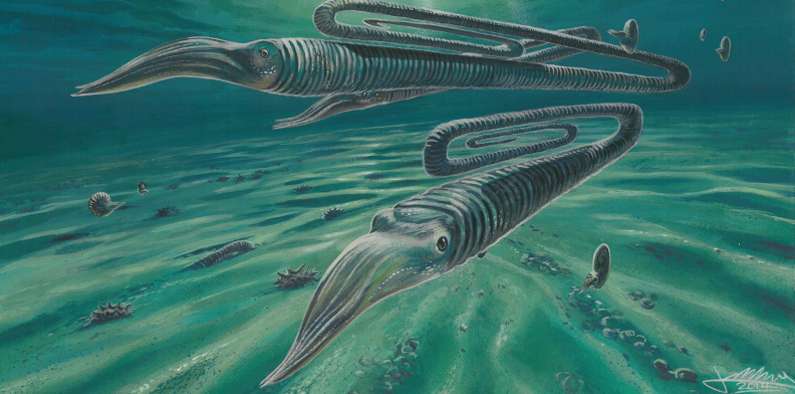Painted reconstruction of typical Cretaceous marine environment in Antarctica, including the paperclip-shaped ‘heteromorph’ ammonite Diplomoceras. Credit: James McKay (jamesmckay.info)
A pair of researchers at Syracuse University has found evidence that an ancient squid-like creature with a paperclip-shaped shell may have lived for hundreds of years. Linda Ivany and Emily Artruc outlined their research at this year's online meeting of the Geological Society of America. They also spoke to the press about their findings.
Diplomoceras maximum lived approximately 68 million years ago (in the waters around what is now Antarctica), at approximately the same time as Tyrannosaurus rex—a period known as the Maastrichtian age of the upper Cretaceous period. D. maximum was a large, squid-like creature (its shell was over 1.5 meters tall), an ammonite that was part of a now-extinct group of tentacled cephalopods. It went extinct at the same time as the dinosaurs, presumably for the same reason: the Chicxulub asteroid strike. What made D. maximum stand out was the unique shape of its shell. The top portion bent back and forth, resembling a paperclip. In this new effort, Ivany and Artruc discovered something else remarkable about the ancient creature—its lifespan.
The research pair were studying the shell of a specimen that had previously been found by other researchers. As part of their work, they were studying its chemical makeup. To that end, they collected samples along the length of its shell at 50 cm intervals. They also conducted oxygen and carbon isotope testing along the shell to learn more about its age in general and how long it might have been alive. In so doing, they found repeating isotopic signatures. The researchers suggest the signatures came about from methane released into the water from the seafloor each year. Because they were surrounded by the water, the methane left a signature covering the D. maximum's shell each year. By adding up the number of ridges on the shell that were formed by the methane, the researchers were able to calculate its age. They found that the D. maximum specimen had lived to be approximately 200 years old.
The researchers suggest their finding is interesting because while some modern shellfish live for approximately 200 years, squid typically only live for four or five years.
Provided by Science X Network
© 2020 Science X Network
























